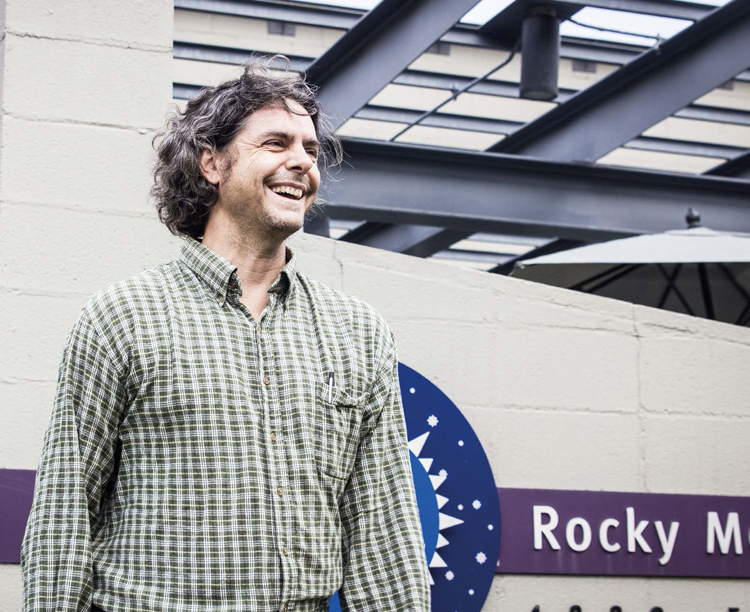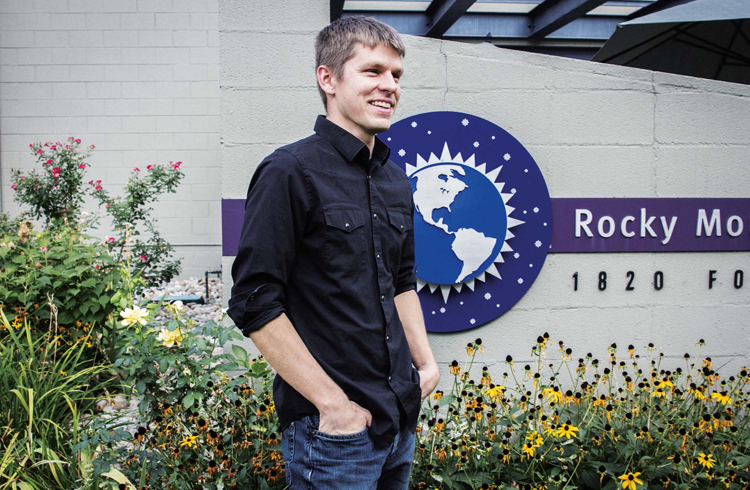 |
|
Victor Olgyay ©BompanEmanuele
|
Boulder, Colorado. Mountains half-surround this small city at the feet of the Rocky Mountains. Not far away shine the higher peaks, some 4,000 metres tall. 30 years ago, this amazing mountain range and its wilderness beauty has inspired the creations of one of the most interesting American think-tank for problem-solving in the energy sector, the Rocky Mountain Institute (RMI), created by Amory Lovins, an American physicist, environmental scientist, and writer. Renewable Matter visited RMI in Boulder to talk to Victor Olgay, son of the famous homonymous architect and author of the first book on bioclimatic architecture.
Victor is an architect, and RMI expert on energy use in the new and existing commercial building sectors. He has worked on hundreds of projects, including the deep energy retrofit of the gigantic Empire State building. The Empire State Building is an example of how critically important the role of existing buildings is in energy saving practices. Brett Bridgeland, RMI senior staff, specialized in smart buildings, and has also joined our pleasant discussion on how buildings fit in a circular economy vision.
 |
|
Brett Bridgeland ©BompanEmanuele
|
When we look at a building we don’t see what it really is: a source of materials (sewage, construction material, waste, discarded products – carpet, windows, etc.) and an opportunity to reduce energy consumption and cut emissions.
Victor Olgyay “At RMI, we try and look at buildings not as single item but as larger ecosystem (e.g. buildings with other buildings, buildings related to urban infrastructure and relationships of building with electricity and mobility).
“In Reinventing Fire (a book by the founder of RMI, Amory Lovins, and a roadmap guiding RMI initiatives) we describe the role of buildings related to energy utilities, mobility and industry. Today when most people look at buildings they don’t use an integrated approach, they see these elements as unrelated and linearly dependent, rather than systematically interdependent. In Reinventing Fire, we show how a systems approach provides the opportunity to eliminate the need for oil and coal, and allows us to develop a robust growing economy based on efficiency and renewable energy.
“For example, today buildings and automobiles should be seen as connected, with electric cars acting as electrical energy storage for the building. Today we have so many inefficient buildings they represent a great opportunity to save energy and money, and to create new business, that tackling efficiency with deep or light intervention.”
You are saying that the immense, energy intensive, real estate stock can become more efficient even with light retrofits?
VO “If we get 20% increase in energy efficiency across a lot of buildings, we create a great impact. Therefore now RMI is now looking how we can get, broad, quick returns on investments in a lot of building. Such interventions should be easy to do, and not cause headaches for building owners. Simple, light efficiency projects that can be done very easily and get a quick return on their investment will be popular and spread broadly.
“Of course we also see the opportunity for extensive retrofits. We are working on communities, networks and campuses of building, that are becoming highly energy efficiency, zero-net energy, and some even produce more energy than they use. These large networks of efficient buildings can become an asset to the electrical grid, a different node in the electrical system. Interconnected groups of buildings can provide thermal and electrical storage, demand response, frequency regulation, and other valuable commodities that help the electrical grid run smoother.
“But the light building retrofit is paradoxically quite difficult. Getting broad, quick and easy intervention is tough. You need to convince many people, with a wide variety of buildings that have different energy use patterns. But we believe there is a real opportunity to do broad retrofits by optimizing and accessing the informational infrastructure of buildings. We are targeting systems that allow us to have a better understanding of how to operate buildings in an efficient manner. Today there are many automated processes, but still they are often not properly manned or maintained. We need to learn to run our buildings well. Rather than spent lots of money on innovative materials, or in expensive envelope improvements, we need to examine how we can use computers and data in a clever way.”
Therefore you suggest that rather than innovating material, we need to innovate building management.
VO “Yes. For existing building, absolutely. Building management is key to operational energy savings. For new buildings, we need to innovate design. Our buildings can work better with better design. Designing with the climate can save a lot of building energy. Just design simple walls that are well insulated and work well, think about the airflow in the building, use quality windows that are shaded in the summer and let beneficial solar heat in the building when desired and you can have significant energy reductions. All these things are free; it’s a matter of smart design. We can build zero energy houses with the materials we have right now, we don’t really need any new super-efficient materials.
“Of course some products like PV panels have had impressive efficiency improvements and a very welcome drop in costs. These are great materials, and there are a number of other good products that are coming to market that make energy efficiency easier and more cost effective. Even to get to super efficient passive house standards we need good design, and careful details, the materials we use can be quite ordinary.”
We humans are key to fixing our buildings and make them live longer and more efficiently.
VO “Behavior is central. It is interesting that people generally lack awareness about energy in buildings. People are cognizant of their car’s mileage-per-gallon but not as aware of the energy consumption of their homes. Without some sort of visible indication of how much energy they are using, there is little incentive for efficient behavior. This is too bad, because energy efficiency results in Negawatts (or energy saved), a powerful and unseen solution that can greatly reduce GHG.”
What can be done?
VO “We have a project called Residential Energy+, a Rocky Mountain Institute initiative enabling industry actors to grab the $150 billion residential energy upgrades market opportunity, and meet the top unmet demand among homeowners: improved home energy performance. Residential buildings represent about one-fifth of U.S. greenhouse gas emissions, with a reduction potential of over 300 million metric tons annually. Despite progress and significant efforts by multiple industry actors, the diffuse residential efficiency market has not yet reached the scale necessary to mitigate the effects of climate change. RMI therefore seeks to motivate and empower homeowners across the United States to invest in home energy upgrades – through energy efficiency and renewable energy – as part of property renovations.
“Once they can visualize information, people become aware and act. We call it ‘the Prius effect,’ from the famous hybrid car: you see the effects of your style of driving and you automatically change your behavior. Particularly in the residential sector it is necessary that energy visualization becomes that simple. Maybe with an app: we love gaming and gadgets. So why not?”
However, can sensors and automation prevent energy waste from our bad behavior?
Brett Bridgeland “Not always. Computer scheduled heating does not always match what is needed. Light sensors don’t always work and sometimes break. Or we don’t do efficient maintenance. Therefore even with automated buildings there will be always a human component. Big data is growing. We need to get data out of buildings, and into a usable form for the people to operate them.”
Let’s focus on US. Is there a rising interest in light retrofit?
VO “There is. And interest grows when people find out on how others are saving energy. We are working in Chicago with the Chicago Retrofit Initiative, which has a target of 20% energy savings, in 5 years. One building owner installed a smart energy control system and in the first year they saved 18% of their total energy. ‘Had we known this we would have done it a long time ago,’ they said. When their story got out, several more building owners immediately imitated it.”
How can buildings fit in circular economy model?
BB “In an RMI publication I wrote we categorized buildings as having three components: structure (concrete, steel, wood); products (furniture, finishes, carpet), and building operation. We wanted to have any every component to be circular.
“Let’s start with structure. Design should include the potential reuse of the built structure, rather than tearing it down. For example, the parking garage at the Boston Convention Center is designed in such a way that can be turned into office spaces. Designers need to think ahead, how to reuse a structure while keeping it intact. In Boston they knew that the Convention Center might revitalize the neighborhood, so changing the parking structure could be an economic opportunity to adapt to a higher value use.
“For products consider for example carpet: over time it wears out and needs to be replaced. So in this case it is fundamental to choose a material that can be easily removed, deconstructed and used again to produce new materials, new carpet in this case. There are many other product examples. And as far as building operation is concerned, it is necessary to keep your building ‘tuned up’, operating efficiently, and update system software and components to reduce consumption as much as possible.”
Thinking ahead is key.
BB “And think circular. For example the prospect of building component prefabrication can boost the circular material flow. When we industrialize the way we produce wall system; we can be constructing standardized components (while increasing construction quality) that can help to reduce material consumption and promote reuse. We save more materials and more energy. There is a new world out there.”
Rocky Mountain Institute, www.rmi.org
Amory Lovins, Reinventing Fire, Chelsea Green Publishing 2011
Project Residential Energy+, www.rmi.org/residentialenergyplus



